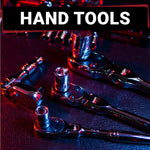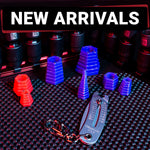The main difference between a torque wrench and a breaker bar is their function and construction. Torque wrenches and breaker bars solve opposite problems: A torque wrench measures and applies precise force to tighten fasteners, whereas a breaker bar provides maximum leverage for loosening stubborn or overtightened bolts.
We'll tell you how torque wrenches and breaker bars work, what sets them apart, and when you should reach for each tool in your garage.
How Breaker Bars Work
A breaker bar has a long handle with a socket drive head at one end. This tool provides maximum leverage to loosen stubborn, rusted, or overtightened fasteners.
Breaker bar sizes typically range from 1/4 to 1/2-inch drive, with 1/2-inch being most common for automotive work. Unlike ratchets, breaker bars have a fixed head without a ratcheting mechanism, though some models include a swivel head that pivots up to 180 degrees.
Breaker bars use long handles to generate leverage. Physics shows that force multiplies with distance from the pivot point. Most breaker bars range from 15 to 40 inches, with 24-inch models common for automotive work.
When you apply 50 pounds of force to a 24-inch breaker bar, you generate 1,200 inch-pounds (100 ft-lbs) of torque—often enough to free stubborn lug nuts that a standard ratchet can't budge.
Breaker bars are typically made of chrome vanadium steel. The extended handle creates space for two-handed operation, so you have maximum control when breaking loose tight fasteners.
The simple design excels at breaking frozen bolts covered in brake dust or corrosion that have seized after years of exposure.
How Torque Wrenches Work
A torque wrench applies precise amounts of force to fasteners according to manufacturer specifications. Unlike a standard wrench or ratchet, a torque wrench contains an internal mechanism that measures and/or limits the force applied.
Most DIY mechanics use click type torque wrenches. These tools contain a calibrated spring mechanism that releases when you reach the preset torque value, producing an audible click and a noticeable drop in resistance.
To use a click type torque wrench, you set the desired torque value using the adjustment knob or digital interface. As you tighten the fastener, the internal spring compresses until it reaches the preset value, then trips to prevent overtightening.
Beam type torque wrenches work differently, using a pointer and calibrated scale. As you apply force, the beam flexes, and the pointer indicates the current torque value. These wrenches require you to watch the scale while tightening, stopping when you reach the target value.
Beam wrench models show the current torque through deflection, while the more advanced split beam design is more accurate and durable.
Digital torque wrenches incorporate electronic sensors and displays that show precise readings. Many include programmable settings, alerts, and memory functions for tracking torque values across multiple fasteners.
The accuracy of a torque wrench depends on proper calibration. Quality models from manufacturers, like Olsa Tools, maintain accuracy within ±4% of the indicated value when properly maintained.
Differences Between Breaker Bars and Torque Wrenches
|
Breaker bar |
Torque wrench |
|
|
Purpose |
Loosening stubborn fasteners |
Tightening fasteners to specification |
|
Design |
Simple fixed or swivel head with long handle |
Complex internal mechanism with calibrated components |
|
Measurement capability |
None (provides leverage only) |
Measures and limits applied torque |
|
Typical length |
15–40 inches |
10–24 inches |
|
Weight |
Lighter due to simple construction |
Heavier because of internal mechanisms |
|
Price range |
$20–$50 |
$40–$200+ depending on type and accuracy |
|
Durability |
Extremely durable with few moving parts |
More delicate because of internal mechanisms |
|
Storage requirements |
Can be stored with regular hand tools |
Must be stored at lowest torque setting and laid flat |
|
Accuracy |
Not applicable |
Typically ±4% when properly calibrated |
|
Usage direction |
Primarily counterclockwise (loosening) |
Primarily clockwise (tightening) |
|
Internal mechanism |
None |
Springs, beams, or electronic sensors |
Maintenance Tips for Breaker Bars and Torque Wrenches
Investing in quality tools means caring for them properly. Here's how to maintain your breaker bars and torque wrenches.
Breaker Bar Maintenance
- Clean after each use, especially when exposed to brake dust or road grime. Use hand wipes or a clean cloth and apply a light coat of oil to protect against rust.
- Inspect the socket head regularly for cracks or damage. A damaged socket head affects the tool's ability to break frozen bolts safely.
- Store in a dry place. Despite their durable construction, breaker bars can corrode if left in damp conditions or where water accumulates.
- Check the swivel head (if present) for smooth operation. Apply lubricant if movement becomes stiff or restricted.
Torque Wrench Maintenance
- Reset to the lowest setting after use. Leaving a clicking mechanism under tension weakens the spring over time and affects accuracy.
- Calibrate annually or after 5,000 cycles. Professional calibration keeps your wrench accurate.
- Never use your torque wrench beyond its specified range. Exceeding a beam wrench or split beam wrench's capacity can permanently bend the beam.
- Avoid dropping your torque wrench. Impact can damage the internal mechanism and throw off calibration.
- Store in the provided case to protect it from dust and moisture. A protective case also prevents contact pressure from other tools in your drawer.
With proper care, your breaker bar will last decades, while your torque wrench will maintain accurate readings for years of precise fastening.
Can You Use a Torque Wrench as a Breaker Bar? (And Vice Versa)
No, you should never use a torque wrench as a breaker bar. The force needed to break stuck bolts will damage the precision mechanism inside your torque wrench and ruin its ability to provide proper torque readings.
Similarly, a breaker bar cannot substitute for a torque wrench because it cannot measure torque settings. While effective on stubborn bolts, breaker bars and impact guns provide no way to know when you've reached manufacturer specifications.
For DIY enthusiasts and professionals alike, the right tool matters. Use breaker bars to loosen, torque wrenches to tighten, and your suspension bolts will thank you.
Torque Wrench vs Breaker Bar FAQ
Is a breaker bar better than an impact wrench?
Breaker bars are excellent at breaking loose stubborn bolts without power sources. Impact wrenches work faster but cost more and require electricity or air. Breaker bars provide better control for initial loosening, while impact wrenches are better at removing multiple bolts quickly. Each serves different needs based on your situation and budget.
Is a breaker bar the same as a cheater bar?
No. A breaker bar is a purpose-built tool with a fixed head and long handle designed for high-torque applications. A cheater bar is any pipe or extension slipped over a regular wrench or ratchet to extend leverage—an improvised, potentially unsafe method that risks damaging your tools.
How much torque can a 1/4 drive take?
A 1/4-inch drive typically handles 30–40 ft-lbs maximum before risking damage. This drive size works perfectly for light applications, like dashboard components or small engine parts. Upgrade to 3/8 or 1/2-inch drives for tasks requiring higher amounts of torque to prevent tool failure.
How much torque can a human apply by hand?
An average person generates about 60–80 ft-lbs of torque with standard tools. This increases to 100–150 ft-lbs with proper leverage. Professional mechanics often reach 200+ ft-lbs with extension bars. Body position and grip strength significantly affect your ability to break tight bolts loose.
What is a torque multiplier?
A torque multiplier is a geared device that increases applied torque through planetary gears. It allows users to tighten or loosen fasteners that require force beyond what standard tools can deliver. It multiplies input force by 2–100 times, depending on the model's gear ratio.
Can I use regular sockets with a breaker bar?
You can use regular sockets or impact sockets with breaker bars. Regular sockets are preferable because when too much force is applied, the socket breaks before the breaker bar. Impact sockets also work with breaker bars, but their thicker sidewalls might limit access, and their increased strength could cause the breaker bar to break when excessive force is applied. In most cases, regular sockets work better.
How do I properly tighten suspension bolts with a torque wrench?
Suspension bolts require precise torque settings to maintain alignment and prevent premature wear. Clean the threads, then tighten the bolts in a cross-pattern sequence until you reach the factory specification. Many suspension components need torquing at ride height rather than when the vehicle hangs on a lift to prevent binding.
What makes a beam style torque wrench different from other types?
A beam style torque wrench uses direct mechanical force display through a pointer that moves against a calibrated scale. Unlike click type wrenches, you watch the gauge while tightening. These wrenches need less recalibration, cost less than other styles, and work well for critical tasks despite their simpler design.
How does a torque adapter affect my readings?
A torque adapter changes your effective torque by multiplying or extending the distance from the pivot point to the fastener. When using extension bars or adapters with a torque wrench, you must adjust your target setting using the formula:
Adjusted setting = Original setting × [L ÷ (L + E)]
L = Wrench length
E = Extension length
Is an impact gun too powerful for everyday fasteners?
An impact gun delivers significant rotational force that can strip threads or break fasteners without proper control. This powerful tool requires experience and restraint. Many DIY enthusiasts overtighten with impact guns and then struggle to remove fasteners later. For everyday maintenance, hand tools provide safer results with a better feel.
What's the ideal torque range for different-size fasteners?
The ideal torque range varies by bolt diameter, thread pitch, and material. For example, a standard M8 bolt typically needs 15–20 ft-lbs, while an M12 needs 60–75 ft-lbs. Always consult manufacturer specifications.








